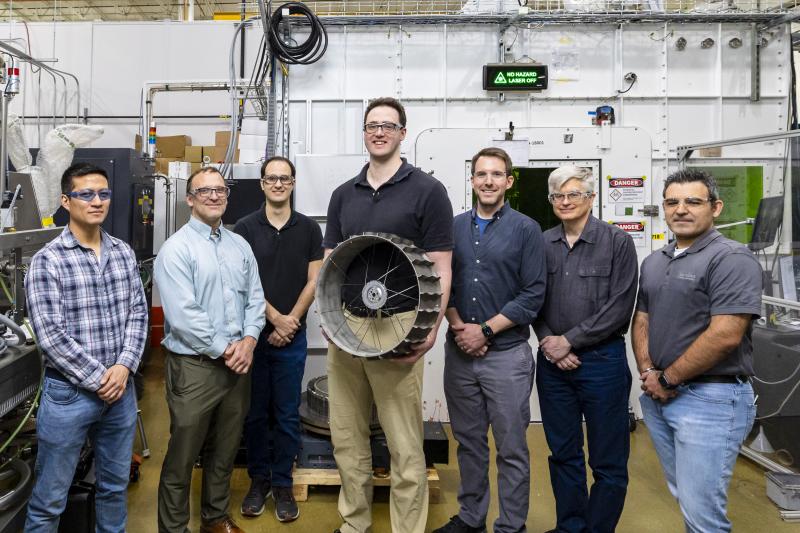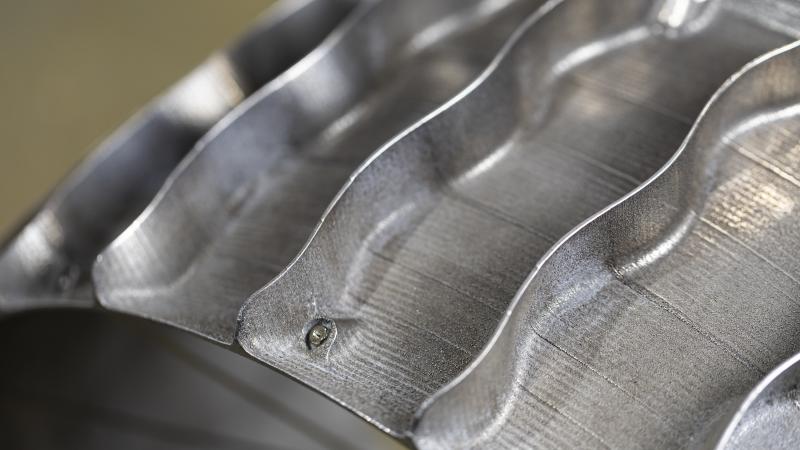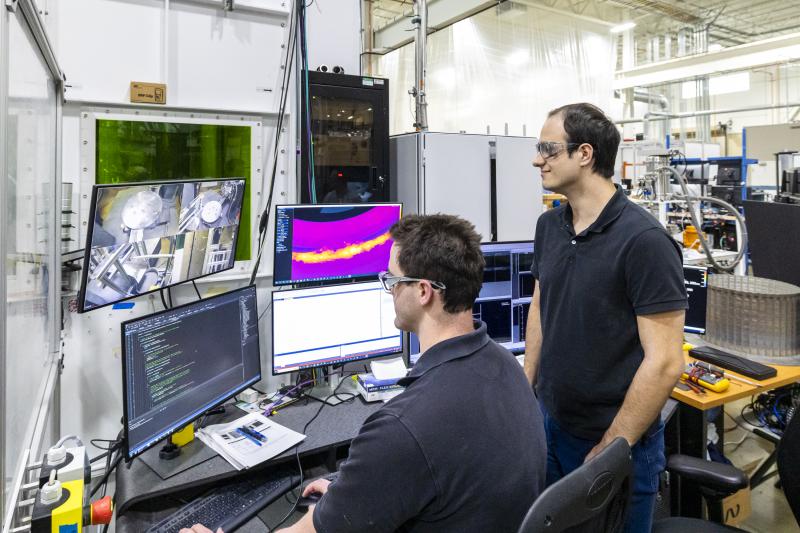Researchers at the Department of Energy (DOE) ‘s Oak Ridge National Laboratory (ORNL) have joined forces with NASA to 3D print a prototype lunar rover wheel, further demonstrating the transformative capabilities of additive manufacturing (AM) for space missions. This collaboration has not only reduced production time but also introduced a complexity in design that traditional methods couldn’t achieve. As NASA gears up to compare the performance of this prototype with a traditionally manufactured wheel slated for lunar use next year, this could have vast implications for future space missions.
 ORNL researchers used powder bed printing to 3D print a lunar rover wheel based on a NASA design. Image courtesy of Carlos Jones/ORNL/DOE.
ORNL researchers used powder bed printing to 3D print a lunar rover wheel based on a NASA design. Image courtesy of Carlos Jones/ORNL/DOE.The 3D printed wheel, inspired by NASA’s robotic lunar rover VIPER—a mobile robot set to explore the moon’s south pole in search of water ice and other volatiles in 2024—highlights the significant leaps being made at ORNL’s Manufacturing Demonstration Facility (MDF). Though this prototype won’t make lunar tracks, it strictly adheres to the design details of VIPER’s wheels. As NASA gears up for VIPER’s crucial mission, this collaboration underscores the adaptability of additive manufacturing for diverse space-focused tasks. Beyond the moon, the lessons from this endeavor could shape future Mars missions and the development of vast space structures.
At the heart of this project is the state-of-the-art 3D printer at MDF. A departure from conventional metal powder bed systems, this printer uses a technique merging two coordinated lasers with a rotating build plate. Then, the metal powder is meticulously melted to shape the desired structure. Peter Wang, who leads MDF development of new laser powder bed fusion systems, emphasized that the printer used for the rover wheel prototype is large enough for a person to enter and is unique in its ability to print large objects. At the same time, the steps occur simultaneously and continuously.
 Members of the team that 3D printed the rover wheel prototype display the result in front of the laser powder bed printer where it was created in ORNL. Image courtesy of Carlos Jones/ORNL/DOE.
Members of the team that 3D printed the rover wheel prototype display the result in front of the laser powder bed printer where it was created in ORNL. Image courtesy of Carlos Jones/ORNL/DOE.“This dramatically increases the production rate with the same amount of laser power,” says Wang, adding that deposition occurs 50% faster. “We’re only scratching the surface of what the system can do. I really think this is going to be the future of laser powder bed printing, especially at large scale and in mass production.”
Wang and project team members recently published a study in the STEM-focused publication Mary Ann Liebert, titled Improved Productivity with Multilaser Rotary Powder Bed Fusion Additive Manufacturing. The research analyzes the scalability of the technology for printing components like electric motors. Wang envisions this methodology transforming the future of mass production, especially for more substantial, intricate projects.
A key achievement of this venture is the cutting-edge software developed at ORNL. The team used this software to “slice” the wheel design into smaller parts and then balance the workload between the two lasers to print evenly, achieving a high production rate and leveraging a computational technique recently submitted for patent protection.
 ORNL 3D prints a lunar rover wheel based on a NASA design. Image courtesy of Carlos Jones/ORNL/DOE.
ORNL 3D prints a lunar rover wheel based on a NASA design. Image courtesy of Carlos Jones/ORNL/DOE.“The project with NASA really propelled the technology forward,” said Brian Gibson, the researcher who spearheaded the rover wheel project for ORNL, calling it a milestone. “It was great to connect a capability with a developing need, and the team was excited to be making a prototype component with space exploration applications.”
Crafted from a durable nickel-based alloy, the printed wheel is impressively large, highlighting the vast potential of AM. This advanced printing method allows the inclusion of intricate patterns and designs without increasing costs or complicating production. On the other hand, VIPER’s wheels, destined for the moon’s terrain, are produced through a more complex assembly and manufacturing sequence.
 3D printing allows fine design details shape for the prototype lunar wheel. Image courtesy of Carlos Jones/ORNL/DOE.
3D printing allows fine design details shape for the prototype lunar wheel. Image courtesy of Carlos Jones/ORNL/DOE.VIPER’s wheel design comprises a staggering 50-piece rim held together by 360 riveted joints. This intricate assembly demands a complex, time-consuming machining process that must meet the rigorous demands of space exploration. If NASA’s evaluations consider the 3D printed prototype in line with or superior to these conventionally constructed wheels, the implications for future rover missions could be game-changing. The 3D printed wheel, which ORNL crafted in just 40 hours, represents a simpler, cost-efficient design. The wheel has a detailed spoke design, yet it’s easier and cheaper to assemble.
Richard Hagen, a key figure at NASA and the AM lab manager at NASA’s Johnson Space Center, emphasizes that 3D printing allows designers to implement features difficult to achieve with traditional methods.
“A lot of these wheel features were put in just to highlight what you can do with additive manufacturing. It lets you easily implement design features that are hard to implement with traditional tooling or even a traditionally machined part.” With ORNL’s capabilities, the prospects of manufacturing much larger rover wheels for lunar and Martian expeditions are within reach.
 ORNL researchers at the MDF monitor the printing of the prototype lunar wheel. Image courtesy of Carlos Jones/ORNL/DOE.
ORNL researchers at the MDF monitor the printing of the prototype lunar wheel. Image courtesy of Carlos Jones/ORNL/DOE.However, there are some challenges. For example, the 3D printed wheel weighs 50% more than the aluminum VIPER wheel. As NASA progresses to evaluate the wheel’s performance in simulated lunar conditions, metrics like maneuverability, slope climbing, and resistance will come into focus.
Beyond immediate applications, the broader implications of AM for space missions are far-reaching. As NASA’s Artemis Program envisions crewed research stations on the moon, the ability to produce parts in space becomes crucial. Hagen highlights the importance of off-planet manufacturing, hinting at the potential of using lunar or Martian materials as feedstock for 3D printers–a previously covered topic.
Funded by NASA and the DOE’s Advanced Materials and Manufacturing Technologies Office, the team at ORNL’s MDF aims to set new benchmarks in manufacturing technologies. Moreover, this collaboration with NASA represents the fusion of science, technology, and ambition, driving humanity’s progress on Earth and beyond.
Subscribe to Our Email Newsletter
Stay up-to-date on all the latest news from the 3D printing industry and receive information and offers from third party vendors.
You May Also Like
Gorilla Sports GE’s First 3D Printed Titanium Cast
How do you help a gorilla with a broken arm? Sounds like the start of a bad joke a zookeeper might tell, but it’s an actual dilemma recently faced by...
Nylon 3D Printed Parts Made More Functional with Coatings & Colors
Parts 3D printed from polyamide (PA, Nylon) 12 using powder bed fusion (PBF) are a mainstay in the additive manufacturing (AM) industry. While post-finishing processes have improved the porosity of...
$25M to Back Sintavia’s Largest Expansion of Metal 3D Printing Capacity Since 2019
Sintavia, the digital manufacturing company specializing in mission-critical parts for strategic sectors, announced a $25 million investment to increase its production capacity, the largest expansion to its operations since 2019....
Velo3D Initiates Public Offering in a Bid to Strengthen Financial Foundations and Drive Future Growth
Velo3D (NYSE: VLD) has been among a number of publicly traded 3D printing firms that have attempted to weather the current macroeconomic climate. After posting a challenging financial report for 2023,...































